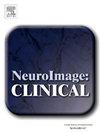Structural brain network in relation to language in school-aged extremely preterm children: A diffusion tensor imaging study
IF 3.6
2区 医学
Q2 NEUROIMAGING
引用次数: 0
Abstract
Between 22 and 45 % of children born preterm experience difficulties with expressive and receptive language when they reach school age. Little is currently known about the neural mechanisms behind their linguistic performance. This study investigates the brain areas and white matter connections that form the structural language network in extremely preterm-born children who have reached school age. Structural brain connectivity was quantified using diffusion-weighted imaging (DWI) and tractography in n = 58 (62 % female) extremely preterm-born children aged 8–12 years. Language outcomes were assessed using the CELF-4-NL Recalling Sentences subtest. Language scores were below average in n = 13 (22 %) children. Language outcomes related significantly to a subnetwork of 16 brain regions (p = 0.012). The network comprised brain regions from the left hemisphere including the pars orbitalis, middle and superior frontal gyrus, frontal pole, pre- and postcentral gyrus, superior temporal gyrus, insula, caudate nucleus, thalamus, and putamen. In the right hemisphere, the anterior cingulate was part of the network. These findings suggest that extremely preterm children rely mostly on their left hemisphere during language processing, which is similar to typically developing children. However, they seem to use compensatory neural pathways that include brain areas right next to the areas typically involved in language processing. These areas include the pars orbitalis (adjacent to Broca’s area) and the putamen and caudate nucleus (adjacent to the limbic system). It is important to note that language difficulties were not necessarily related to brain injury around birth.
学龄极早产儿大脑结构网络与语言的关系:弥散张量成像研究
22%至45%的早产儿童在学龄时经历表达和接受语言方面的困难。目前,人们对其语言表现背后的神经机制知之甚少。这项研究调查了极早产儿童的大脑区域和白质连接,这些区域和白质连接形成了结构性语言网络。采用弥散加权成像(DWI)和脑导管造影对58例(62%为女性)8-12岁的极早产儿进行脑结构连通性量化。使用CELF-4-NL回忆句子子测试评估语言结果。13名(22%)儿童的语言成绩低于平均水平。语言结果与16个大脑区域的子网络显著相关(p = 0.012)。该网络包括来自左半球的大脑区域,包括眶部、额上回、额极、中央前后回、颞上回、脑岛、尾状核、丘脑和壳核。在右半球,前扣带是网络的一部分。这些发现表明,极早产儿在语言处理过程中主要依靠左半球,这与正常发育的儿童相似。然而,它们似乎使用了代偿性神经通路,其中包括大脑中与语言处理相关的区域相邻的区域。这些区域包括眶部(毗邻布洛卡区)和壳核和尾状核(毗邻边缘系统)。值得注意的是,语言障碍并不一定与出生时的脑损伤有关。
本文章由计算机程序翻译,如有差异,请以英文原文为准。
求助全文
约1分钟内获得全文
求助全文
来源期刊

Neuroimage-Clinical
NEUROIMAGING-
CiteScore
7.50
自引率
4.80%
发文量
368
审稿时长
52 days
期刊介绍:
NeuroImage: Clinical, a journal of diseases, disorders and syndromes involving the Nervous System, provides a vehicle for communicating important advances in the study of abnormal structure-function relationships of the human nervous system based on imaging.
The focus of NeuroImage: Clinical is on defining changes to the brain associated with primary neurologic and psychiatric diseases and disorders of the nervous system as well as behavioral syndromes and developmental conditions. The main criterion for judging papers is the extent of scientific advancement in the understanding of the pathophysiologic mechanisms of diseases and disorders, in identification of functional models that link clinical signs and symptoms with brain function and in the creation of image based tools applicable to a broad range of clinical needs including diagnosis, monitoring and tracking of illness, predicting therapeutic response and development of new treatments. Papers dealing with structure and function in animal models will also be considered if they reveal mechanisms that can be readily translated to human conditions.
 求助内容:
求助内容: 应助结果提醒方式:
应助结果提醒方式:


